Abstract
Several physics-based enhancements are embedded in a low-fidelity general unducted rotor design analysis tool developed, py_BEM, including the local Reynolds number effect, rotational corrections to airfoil polar, stall delay model, high induction factor correction, polar at large angle of attack, exergetic efficiency calculation and momentum-based loss. A wind turbine rotor is analyzed in high fidelity designed from py_BEM using a 3D blade generator. It is a design derived from the NREL Phase VI rotor. Three design variations are analyzed using steady 3D CFD solutions to demonstrate the effect of geometry on aerodynamics. S809 and NACA 2420 airfoil properties are used for calculating the aerodynamic loading. Momentum, vorticity and energy transport are explained in depth and connected to entropy production as a measure of performance loss. KE dissipation downstream of the rotor is shown to be a significant contributor of entropy rise. Wake analysis demonstrates mixing with the free stream flow, which begins after 3 diameters downstream of the rotor and extends to about 25 diameters until the decay is very small. Vorticity dynamics is investigated using a boundary vorticity flux technique to demonstrate the relationship between streamwise vorticity and lift generated in boundary layers. Drag components are accounted as well. It is demonstrated using rothalpy that shaft power is not only torque multiplied by rotational velocity but a viscous power loss term must also be included. A multifidelity analysis of wind turbine aerodynamics is demonstrated by capturing flow physics at several levels.
1. Introduction
Wind energy has gained enormous traction over the past two decades as a sustainable source of electric power and a carbon-emissions-reduction enabler. Multi-megawatt projects all around the world have enabled engineering practices to be nimble and reliable. Low-fidelity designs and analysis of wind turbines provide a good baseline for further aerodynamic improvements in the high-fidelity chain. Blade element momentum theory has become very popular and is an integral part of the wind turbine design process. It is derived from the combination of blade momentum theory (BMT) and blade element theory (BET) [1,2,3,4,5,6,7,8]. Some of the other methods include lifting line theory and vortex sheet method [9]. AeroDyn [10], Qblade [11] and most other tools have utilized airfoil polar data from XFOIL [12]. Other authors have connected their BEMT tool with analytical (linear lift and quadratic drag model) or experimental data banks of several airfoils for the polar data or use circulation distribution [9] of rotor design. Sant et al. [13,14] and Merrill [15] improved the BEM models with blade pressure measurements. Several authors add different 3D corrections [16,17,18,19] since the data are for static 2D airfoils. Zhong et al. [20] proposed a new method to determine angle of attack for rotating wind turbines using CFD to capture accurate polar data. Revaz et al. [21] coupled wall-resolved LES and BEMT to obtain airfoil characteristics. Only a handful have included appropriate Reynolds number corrections [22,23,24]. Tip loss corrections [25,26] and modifications to include the radial velocity effect for wake expansion are constantly being added [27]. The BEMT model, being a reduced order model, compares well with experimental results with necessary corrections, and, being computationally fast and relatively simple, it is the most popular method used in early design stages. However, it does not predict well for scenarios with variable flow conditions, high levels of turbulence and shear. A CFD method is used in lieu of XFOIL to obtain more accurate results, which is coupled with the BEMT model, and the blades are designed as actuator disks [28,29].
High-fidelity analysis of wind turbines is performed to understand the flow behavior downstream of the blades in detail using steady and unsteady CFD or LES. Possible factors that reduce the thermodynamic efficiency are processes leading to exergy (available work) destruction and entropy generation. Increasing the efficiency can also be attained by energy quantification applying the second law of thermodynamics, which relates to entropy, exergy and other concept generation [30]. Stickle et al. [31] defined axial and rotational momentum loss based on experiments conducted, and Denton provided a detailed account of entropy-based loss [32]. Masters et al. [26] compared BEMT–CFD with the blade-resolved geometry (BRG) CFD method in terms of velocity deficit. Lawson et al. [33] showed that computational time-step has a minimal effect on the solution and that the mesh needs to have a higher density for results comparable to experimental data. Aranake et al. [34] demonstrated that a transition model improves 3D solution quality during small separation regions at low velocity and improved 2D validation of S827 airfoil with the experimental data. Rui et al. [35] investigated the entropy change in the turbulent boundary layer and related it to the viscous dissipation using direct numerical simulation (DNS) for free-shear-layer-based flows. Martini et al. [36] reviewed different methodologies to predict power loss in wind turbines due to adverse meteorological conditions, with a modeling approach including both BEMT and CFD for the last 15 years. Siddiqui et al. [37] demonstrated the effect of reduced geometric or numerical approximation on high-fidelity aerodynamic performance of wind turbines compared with experimental data. Capturing transitional flow for a turbulent application such as wind turbines is crucial, and Michna et al. [38] demonstrated the accuracy of several transition models for a thick airfoil.
The scope of this paper is in connecting low- and high-fidelity tools for wind turbine blade aerodynamics, improving the accuracy at each fidelity and understanding the flow physics to show the complex energy transfer occurring and demonstrating performance loss at certain locations is inevitable through exergy destruction. A novel way of understanding lift generation on the wind turbine blade through vorticity dynamics and propagation of loss downstream is demonstrated. A tool based on BEMT was developed in-house, py_BEM, which generates spanwise stagger and chord definitions for 3D blade creation. Apart from the standard tip loss model, airfoil polar from Xfoil, local effects of Reynolds numbers are incorporated varying spanwise. Accurate airfoil polar data are essential in low-fidelity tools and several enhancements to lift and drag polar are demonstrated for transition zone [39], stall regime, rotational effect and stall delay [40,41]. The two-bladed NREL Phase VI wind turbine rotor is reverse engineered and validated with the NREL experimental results [42,43,44,45,46,47]. The results from py_BEM are converted into a 3D blade shape and analyzed in a 3D steady RANS CFD solver. Wake analysis, vorticity dynamics, kinetic energy dissipation and airfoil loading comparison between the two fidelities are presented to highlight the limitations and advantages of each approach. Entropy as a true measure of performance loss is demonstrated using 3D steady RANS CFD results.
2. Methodology
Small- and large-scale wind turbines can be designed and analyzed using a low-fidelity tool developed in-house, py_BEM, with local Reynolds number effects. Blade element momentum theory, as seen in Figure 1, was enhanced with correction to improve prediction accuracy. Wind turbine blades have the highest aspect ratio among all the unducted rotors and hence should be designed accounting for lift-induced drag, stall, post-stall and hub-region effects. Spanwise twist and chord distribution along with 2D airfoil shapes and their polar contribute to low-fidelity design data, which can be connected to higher-fidelity tool chain. Calculating angle of attack (AoA) near the hub region is crucial for BEMT code convergence since the values usually exceed the stall angle at the hub, so a model for polar extrapolation becomes necessary to obtain a converged solution. Most of the large-scale wind turbines have cylindrical hubs, and the ability to include this shape while generating 3D blades is also demonstrated. Fluid properties chosen are air at 20 °C with a density of 1.225 kg/m3 and kinematic viscosity of 15.68 × 10−6 m2/s.
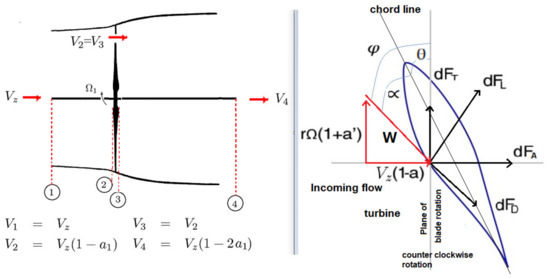
Figure 1.
Blade element and momentum theory for wind turbine.
A wind turbine rotor was designed and analyzed derived from the NREL Phase VI rotor [42,43,44,45,46,47] through reverse engineering. The inlet velocity for design point was 7 m/s. Three design variations are presented here to understand the flow behavior, effects of airfoil shapes and AoA with local variation of Reynolds number spanwise. All three designs had spanwise variation in Reynolds number. The first design generated was with chord and flow angles calculated from the low-fidelity tool developed and was compared with the second design obtained using chord from the NREL report, both at constant AoA and S809 airfoil polar. The second design included a transitional airfoil near the hub. The third design was created using a NACA2420 airfoil in 3D, varying AoA spanwise, obtained using the py_BEM tool run in analysis mode using S809 airfoil polar with given chord from NREL report and a circular transitional hub airfoil. The analysis was focused on understanding the performance difference due to geometry at the hub and the blade properties obtained by the BEMT tool with physics enhancements and those from the published report with suitable airfoil polar data when analyzed in high fidelity.
- WTdesign1: constant AoA of 8 degrees spanwise with S809 airfoil with properties from py_BEM calculation.
- WTdesign2: constant AoA of 8 degrees spanwise with S809 airfoil and chord from NREL report [42,43,44,45,46,47].
- WTdesign3: spanwise variation of AoA with NACA2420 airfoil and chord from NREL report [42,43,44,45,46,47] with cylindrical hub.
The results of py_BEM are converted into a 3D blade shape for further analysis in high-fidelity framework using a blade generator [48]. As an additional study to improve airfoil characteristics, curvature-controlled 2D airfoil generation is demonstrated, which has a minimized drag coefficient compared to S809 airfoil. A complete account of loss propagation in the computational domain is described. Loss generation in the boundary layer as entropy through boundary vorticity flux analysis and propagation to immediate domains around the blade leading to tip and hub loss, which travels further downstream and becomes mixed out with free stream, is depicted in Figure 2.

Figure 2.
Loss propagation for a wind turbine starting from the boundary layer.
2.1. Airfoil Properties with Corrections at Low Fidelity
Airfoil properties are essential components in predicting the performance of an unducted rotor using low-fidelity approaches such as BEMT. An airfoil polar can be obtained from several methods: experimental results, XFOIL/RFOIL runs and 2D/3D CFD analysis, and it is very difficult to obtain similar values. The turbulence intensity levels in experiments and in simulations need to be matched very well. Figure 3 shows the difference in lift coefficients for S809 airfoil at Re = 1.0 × 106 from XFOIL runs and experimental results from two different wind tunnel setups, Delft and Ohio State [42,43,44,45,46,47].
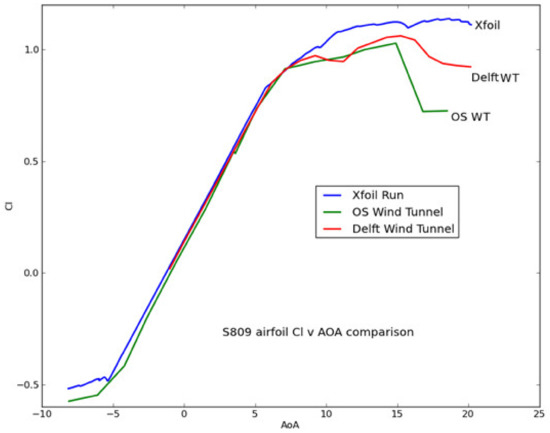
Figure 3.
Cl vs. AoA plot showing the difference between XFOIL run and wind tunnel data at Delft and Ohio State University for S809 airfoil at Re = 1.0 × 106.
The lift and drag polar for our purposes are obtained from XFLR5/XFOIL runs for a range of Reynolds numbers and AoAs for several airfoils. XFOIL incorporates turbulence level variation while calculating airfoil polar using a non-dimensional value called NCRIT. NCRIT values used in XFOIL are usually taken as nine for clean inflow, and Figure 4 shows the difference in lift and drag polar of S809 airfoil at a Reynolds number of 0.65 × 106 for two different NCRIT values of 5 (turbulent flow) and 9 (clean inflow).
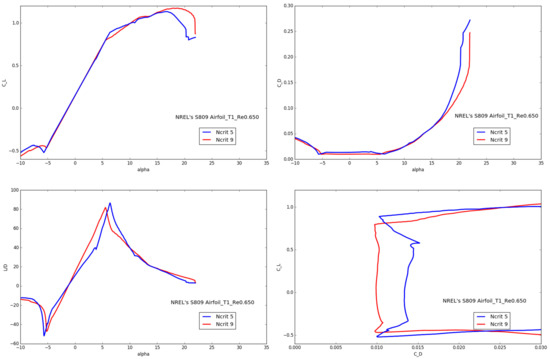
Figure 4.
S809 polar comparison for NCRIT values of 5 (turbulent flow) and 9 (clean flow) at Re = 0.65 × 106 obtained from XFOIL.
Rotation of unducted rotors delays stall due to Coriolis force and centrifugal pumping of flow radially outwards. This effect is called the Himmelskamp effect [16,17,18,19], and when stall occurs, flow on the suction surface is decelerated and starts to separate. Due to centrifugal force caused by rotation, flow tends to move from hub towards tip, delaying the separation, resulting in higher lift coefficients than 2D experimental measurements or non-rotating numerical simulations. Centrifugal effects depend on the local aspect ratio. Coriolis forces accelerate the flow in chordwise directions towards the trailing edges reducing adverse pressure gradients [47]. Polar obtained from prior methods are 2D because they are either from a wing wind tunnel experiment or 2D airfoil runs in XFOIL or 2D/3D CFD analysis. Three-dimensional rotational corrections are added to obtained 2D airfoils in py_BEM developed in-house [49] using the Du and Selig model [24,50]. Figure 5 shows polar with and without 3D rotational corrections along with a post-stall extrapolation. It is clear from the figure that stall delay occurs from rotation of the rotor and the lift coefficient is higher when these corrections are accounted for. Figure 6 shows a 3D plot of the S809 airfoil polar varying with AoA and Reynolds number. Cl and Cd plotted are 3D values including rotational corrections.
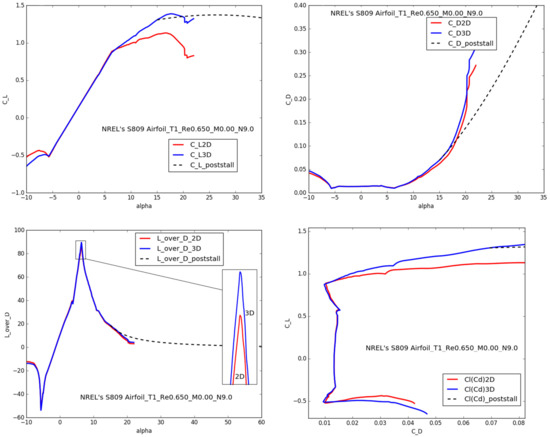
Figure 5.
Comparison of the polar with (blue) and without (red) 3D rotational corrections for S809 airfoil at Re = 0.65 × 106.
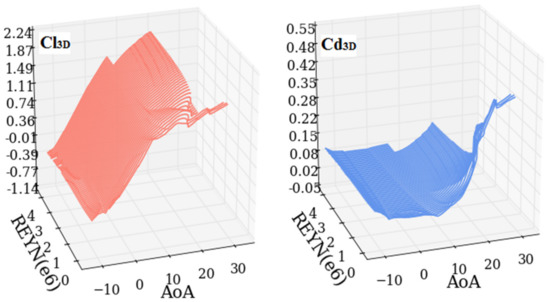
Figure 6.
3D plot of S809 airfoil polar varying with AoA and Reynolds number.
Flow angles near the hub are higher as compared to any other radial section. Usually, AoA is kept constant, so the blades are twisted to compensate. The higher the flow angle, the higher the twist, and, sometimes, twist is more inwards than outwards. However, manufacturing constraints limit blade twist, which makes the hub region operate in stall for wind turbines. Hence, airfoil polar tables must be extended to a larger range of AoA beyond stall angle. Viscous effects dominate the stall regime, and it is difficult to determine airfoil characteristics beyond stall numerically or experimentally. Extrapolation of polar using flat plate theory at higher AoA is a valid solution for such situations. It is based on the similarity between the airfoil and the flat plate at such AoAs. Few researchers have used the Viterna model [17,18], which is an empirical method for calculating polar at higher AoA and is used in the developed BEMT tool. An airfoil polar at higher AoA is essential to obtain a successful convergence with the BEMT approach. Figure 7 shows polar extrapolation for S809 airfoil at Re = 1.0 × 106. For wind turbines above 14 m/s, aspect ratio is taken as 50, which represents an infinite wing [17]. This was performed to match with the experimental values of the NREL Phase VI wind turbine as part of the validation process.
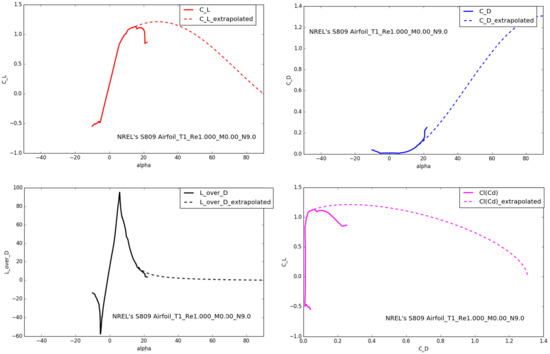
Figure 7.
Polar extrapolation at high AoA for S809 airfoil at Reynolds number of 1.0 × 106.
Transition location is crucial in understanding the onset of turbulence and relates to skin-friction drag and stall phenomenon. At large AoAs, transition to turbulence occurs near the leading edge on the top surface. XFOIL calculates transition location for top and bottom surfaces, and Figure 8 shows a 3D plot of top and bottom surface transition locations of S809 airfoil for a range of AoAs and Reynolds numbers. Transition location behavior with speed and angle of attack is very clear from the plot and is useful in off-design analysis. The transition process for α ≥ 6 degrees apparently occurs in free shear layers, developing after laminar separation and followed by turbulent reattachment downstream. At lower AoAs, transition precedes laminar separation, as explained by McCroskey [39]. The plot shows raw data extracted from XFOIL.
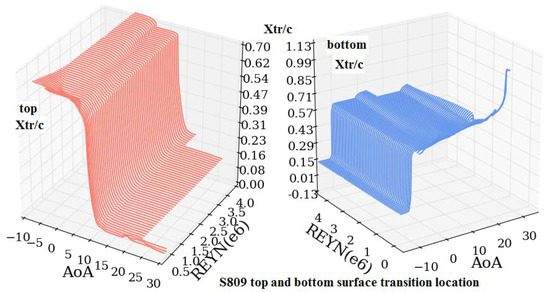
Figure 8.
Three-dimensional plot of S809 airfoil top and bottom surface transition location varying with AoA and Reynolds number.
2.2. Low-Fidelity Design, Off-Design and Validation Using BEMT Tool
The py_BEM tool is a robust tool developed as part of the design analysis framework and uses a combination of blade momentum and element theories to obtain spanwise blade properties, thrust and power. Airfoils can be chosen from an existing data bank or even created as an option using T-Blade3 [48,51,52], which use airfoil curvature to create blade shape by integrating it twice and obtaining meanline, adding thickness to it and joining leading and trailing edges. The default spanwise chord definition used is the chord obtained for maximum power for the entire blade assuming drag coefficient to be zero, a = 0.33 and a′ = 0.0, which is given by the below equation. Another option created is to define a chord multiplier that scales the default or defined chord smoothly. Chord multipliers are defined as several control points spanwise to create a smooth parametric cubic B-spline [53], which is then multiplied to the default chord. Elemental thrust and torque equations are solved together for induction factors using the below relations as shown in Figure 1.
Table 1 lists the design specifications at 7 m/s. Fluid properties chosen are air at 20 °C with a density of 1.225 kg/m3 and kinematic viscosity of 15.68 × 10−6 m2/s. Most of the large-scale wind turbines have cylindrical hubs, and the ability to include this shape while generating 3D blade is also demonstrated. Several designs were created with different hub airfoil sections, as shown in Figure 9, and a cylindrical hub was chosen without a transitional airfoil shape. Figure 10 shows the pressure force along S809 airfoil at different spanwise locations and the boundary layer developed near the trailing edge in XFOIL using free transition model. Numeca’s Autogrid mesher [54] is used to generate the transitional airfoil while meshing in 3D. Figure 11 shows spanwise aerodynamic properties for the representative blade of the reverse-engineered NREL Phase VI wind turbine.

Table 1.
Design specifications of wind turbine input to py_BEM.
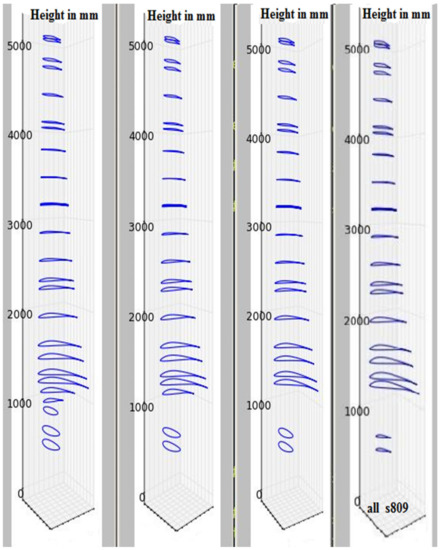
Figure 9.
Different hub configurations for the reverse-engineered wind turbine blade design using py_BEM and created 3D geometries using TBlade3.

Figure 10.
Pressure forces and boundary layer of S809 airfoil calculated using XFOIL with varying AoA spanwise.
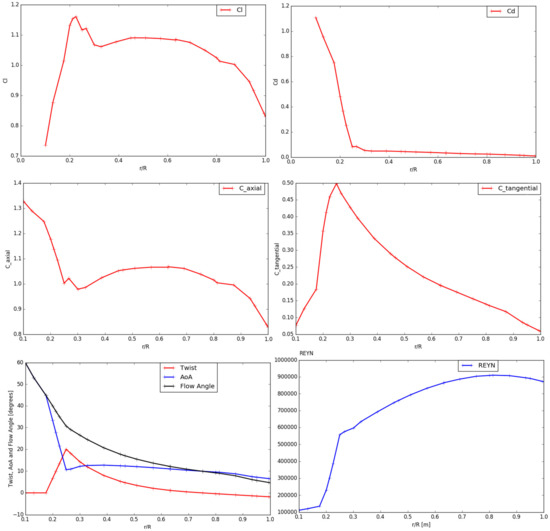
Figure 11.
Spanwise aerodynamic properties of the reverse-engineered NREL Phase VI wind turbine derived designed using py_BEM showing twist, AoA, lift and drag, axial and tangential force coefficients and Reynolds number variation using py_BEM.
Off-design analysis is performed and validated with experimental results [42,43,44,45,46,47] by varying the flow speed to create a performance curve with S809 airfoil polar from XFOIL runs. The RPM, chord and twist were kept constant. Figure 12 shows the spanwise aerodynamic properties for the off-design analysis for varying tip speed ratios (TSR) from 2.37 to 5.41. The ETA vs. TSR subplot in Figure 12 shows that tangential (rotational) momentum loss is tiny compared to axial momentum loss, and the largest loss is due to other factors, which are due to irreversibility causing entropy to increase. The py_BEM off-design power generated was compared with the experimental results of NREL [42,43,44,45,46,47], and Figure 13 shows that it is suitably comparable and validated.
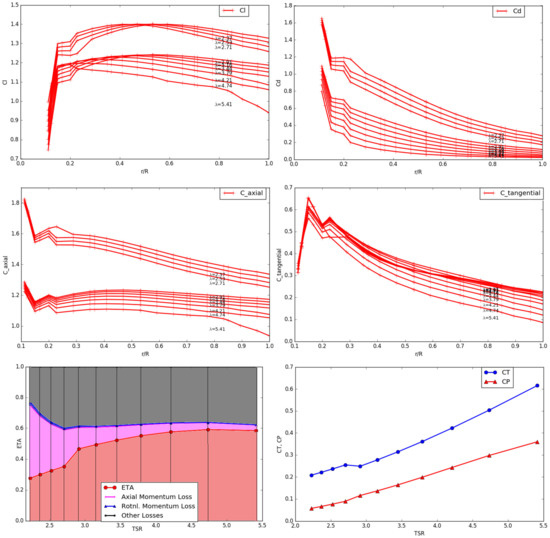
Figure 12.
Spanwise properties of the reverse-engineered NREL Phase VI wind turbine rotor at several off-design points analyzed using py_BEM at various tip speed ratios showing coefficients of lift, drag, axial and tangential force, thrust, power and efficiency including momentum loss.
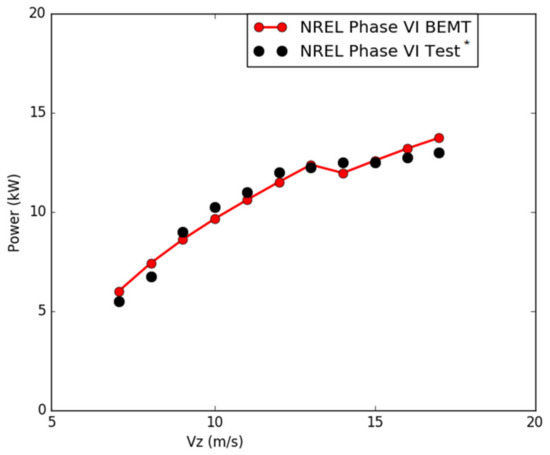
Figure 13.
Validation with experimental results for the reverse-engineered NREL Phase VI wind turbine rotor at several off-design points analyzed using py_BEM.
2.3. 3D Geometry and 3D Simulation Setup
Stagger and chord data from py_BEM were utilized to create a 3D blade in T-Blade3. The airfoil shape can either come from an external source such as S809, NACA series or any other tested database. An optimum airfoil shape can also be generated using the curvature-driven option in T-Blade3 as depicted in Figure 14. The parameterization ensures curvature and slope of curvature continuity on the airfoil surface, which are critical to smooth surface pressure distribution. As a proof of concept, a unique airfoil was created using an in-house optimization framework [48]. Drag coefficient improvement ranging from 17% to 55% for a Cl between 0.3 and 1 was achieved. S809 horizontal axis wind turbine laminar-flow airfoil, which is 21% thick, was used as a benchmark for comparison with this method.
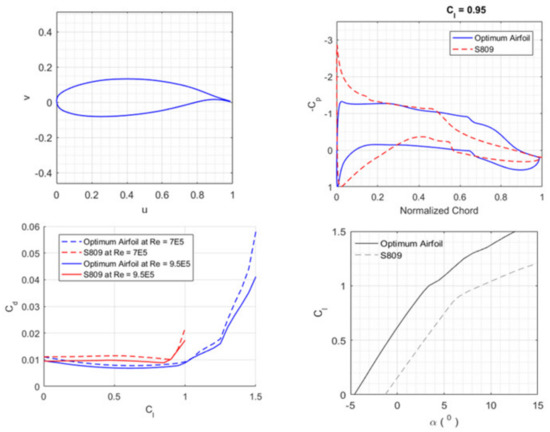
Figure 14.
Curvature-controlled optimum blade shape showing minimized drag coefficient as compared to S809 airfoil at Reynolds number of 9.5 × 105.
Numeca’s Autogrid and FINE/Turbo [54] package v 11.1 containing EURANUS solver was used for the 3D steady CFD analysis and CFVIEW for post-process. The solver has multigrid convergence acceleration, laminar-turbulent transition model and python-scripting capability, which makes the analysis process quicker when run in parallel. A RANS solver was mainly used for the 3D steady simulations with air (perfect gas) as fluid for incompressible (Mach < 0.3) flow calculations with Merkle preconditioning. SA turbulence model with AGS transition scheme was used. The Euler condition was imposed on the hub, and a no-slip condition was imposed for the blade in solid boundary conditions. Rotating matching periodic boundary condition and axial velocity, static temperature and pressure are provided in external boundary conditions with a turbulent viscosity of 0.0001 as default. Hub shape and the tower are not simulated in this study.
Autogrid5 from Numeca is used to create multi-block structured grids using the default option of O4H topology with O-grid block around the blade with 131 points and 4 H-grid blocks defining the upstream, top and bottom of the blade section and downstream blocks. An axisymmetric grid is created, and a conformal mapping of the blade-to-blade grids at several spanwise locations results in 3D grids and can be optimized at every step. A total of 16 blocks are created for the entire 3D grid with 73 meridional flow paths and default clustering at hub and blade tip. Far field meridional domain consists of 101 flow paths with default clustering ensuring smooth transitions between the blade and far field meridional domains. More details of the grid are explained in detail by Siddappaji [49].
Two levels of grids were created for all the numerical simulations, 111 as coarse and 000 as fine. The 3D grids depend on the curvature and aspect ratio of the geometry modeled. Poor-quality grids hinder solution convergence and sometimes introduce solution instability. Standards for orthogonality minimum (>20), stretch ratio maximum (<2) and aspect ratio maximum (<5000) were established [54], and, although the grids created for several cases exceed these typical limits, these values occur in only a few cells away from the blade and are not severe. Figure 15 shows coarse and fine mesh densities for all three domain sizes, and the mesh density around the blade was kept constant to obtain comparable results in coarse and fine categories, respectively.

Figure 15.
Axisymmetric mesh for domains 1X, 2X and 3X for coarse and fine density. The density in the blade vicinity is maintained for all the domain sizes. The three-dimensional blade surface grid with a circular airfoil near the hub is also shown.
Figure 15 shows WTdesign3 with NACA 2420 airfoil spanwise and circular airfoil near the root. It also shows the mesh density for a smooth distribution near the root. Root curvature and shape influences the turbine performance, as it sets up the radial flow due to rotation and hub vortices, which become part of the wake downstream. The circular hub is stacked at its centroid, and the blade at 30% chord. Figure 16a–c shows the grid metrics for a representative wind turbine geometry (reverse-engineered representative NREL Phase VI), the grid dependency study showing thrust values for a range of mesh count and the periodic 16 blocks around the blade. The 3D steady Reynolds-Averaged Navier–Stokes (RANS) solution is computed with the Spalart–Allmaras turbulence and Abu-Ghannam/Shaw transition model activated to capture the flow transition. Figure 17 shows a typical cylindrical domain for a wind turbine 3D simulation with monitoring convergence using torque and thrust values. Domain dependency study is performed with extending domains upstream, far field and downstream and are termed as 1X (5R-5R-25R), 2X (10R-10R-30R), 3X (15R-15R-40R) and 4X (20R-15R-60R). Domain size affects the drag more than the lift and must be investigated in order to use the smallest domain appropriate for high-fidelity analysis. Wind turbines have circular cross sections near the hub for assembly, structural and pitching reasons. The py_BEM tool uses S809 airfoil lift and drag polar for the entire span and does not use circular airfoil sections near the root. Solutions with coarse and fine mesh for 1X, 2X and 3X domains are also calculated. Figure 18 shows the intermittency on the pressure and suction side for the second rotor design, indicating the transition zone chordwise as the value deviates from 0 (laminar) towards 1 (turbulent). The transition location is near 50% chord up to 95% span, and, in the top 5%, it moves towards the trailing edge.

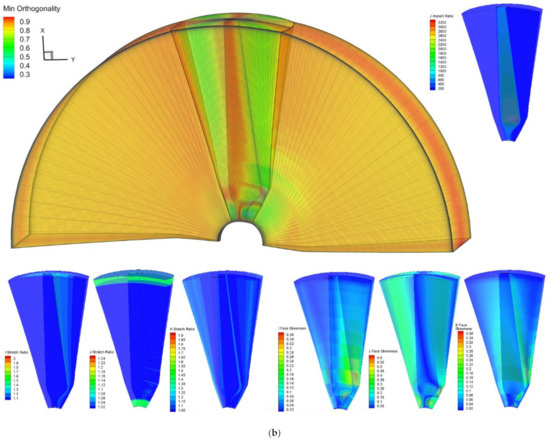

Figure 16.
(a) Grid independency study showing the thrust values for a range of mesh. (b) Grid metrics for a representative wind turbine geometry. Clockwise from bottom left corner is min. orthogonality, J aspect ratio, IJK face skewness and IJK stretch (expansion) ratio. (c) Sixteen blocks around the blade. Mesh with periodicity 1 is shown here for a 2X domain (15R-10R-40R) with extended downstream. Cross-section grid of S809 airfoil is also shown here along with topology.
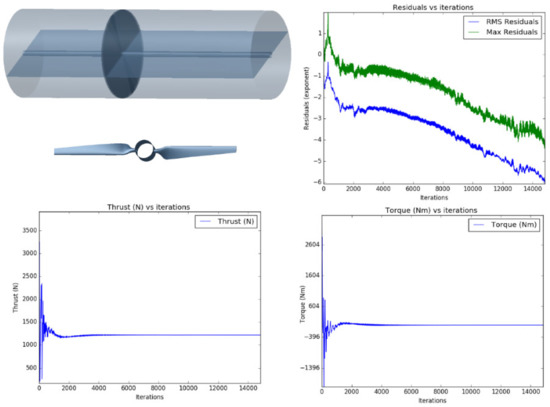
Figure 17.
Fluid domain for the wind turbine rotor domain with convergence of thrust and torque values.
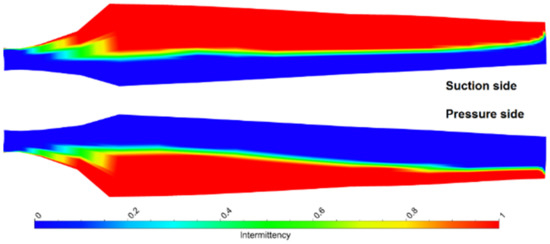
Figure 18.
Intermittency shown on pressure and suction side of the rotor representing onset of turbulent flow.
3. Results
This section contains an explanation for realistic coefficients of thrust and power through analytical reasoning, comparison between low- and high-fidelity results, momentum and wake analysis, vorticity dynamics, drag, rothalpy and viscous power loss.
3.1. Realistic Coefficients of Thrust and Power
Actuator disk theory tells us that is the sum of and , which become the irreversibilities in the control volume [55]. The ratio of irreversibilities to the actual work done is a good measure of how efficient the system is in converting the incoming exergy to useful work. Minimizing this ratio leads to improvements in system performance.
Betz limit [56,57] describes an upper limit for the achievable as 0.5926 at an axial induction factor of 0.333, and beyond this value, the curve monotonically decreases. Realistic is, however, smaller than due to the losses created by the blade profile, spanwise twist, rotation and the relative flow. Blade Momentum Theory (BMT) gives a simplified version of the performance coefficients as a function of the axial induction factor, a.
BET for an airfoil section at a specific radius, r, accounting for the glide ratio, tip speed ratio, solidity, twist and angle of attack gives the following relations, which are also summarized in Figure 19.
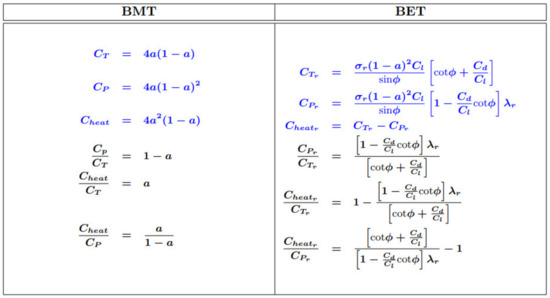
Figure 19.
Performance coefficients for blade momentum and element theory.
A second-law-of-thermodynamics approach gives the exergy or the availability relation. Figure 20 plots the BMT-based performance coefficients for the case with no loss as a function of the axial induction factor. It shows the maximum at a = 0.3333, which follows the Betz limit of power extraction. It is interesting to note that at obtained when a = 0.3333, the is exactly 50% of the and one third of . After this point, the decrease in is due to the increase in , which is clear in Figure 20, and after reaching , the curve starts decreasing. Figure 21 reveals that exergy efficiency always decreases with axial induction factors while curve increases. The entropy–power ratio is very useful in estimating the quality of power production, as it quantifies the amount of irreversibilities created to the amount of useful power generated in turbines, and it is evident that, at higher axial induction factors, the turbulence creates higher amount of irreversibilities, which reduces the power production. Thus, the favorable zone for axial induction factor a is 0.0–0.33, but, realistically, it is further reduced on both sides of the bound due to the structural and 3D flow effects of the blade geometry.
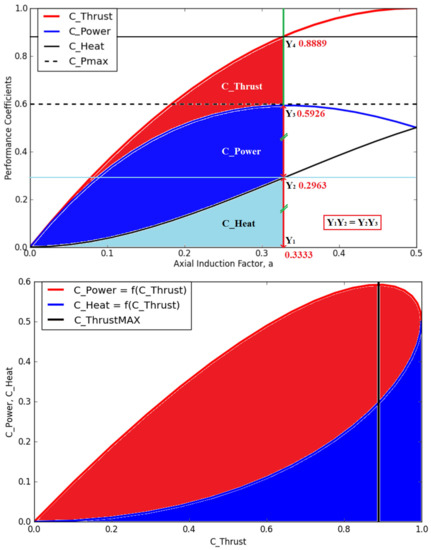
Figure 20.
BMT-based performance coefficients w.r.t axial induction factor for unducted turbines with no tip loss (ideal case). BMT-based realistic power coefficient as a function of CT.
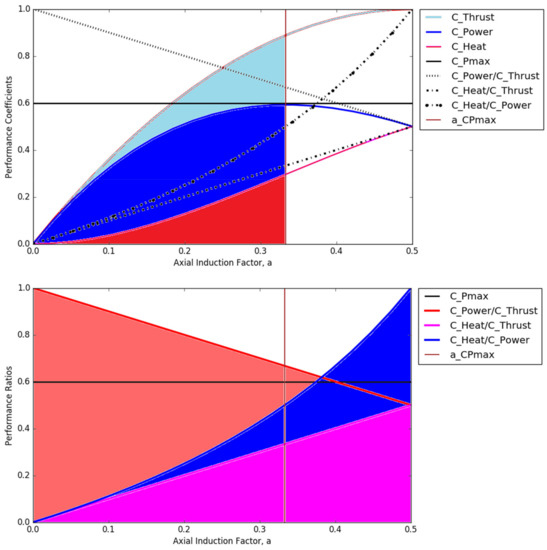
Figure 21.
BMT-based performance ratios with exergy approach for ideal case unducted wind turbines. BMT-based performance ratios using an exergy approach.
The effect of tip speed ratio, flow angle, solidity, and L/D on the performance coefficients using BMT and BET is demonstrated here to show the realistic zone for and . A radial section of a representative of the NREL Phase VI rotor is analyzed to show the variation of these parameters with the axial induction factor and performance coefficients, and it becomes clear that the flow angle (twist + AoA) has a larger impact followed by solidity and TSR. Figure 22 and Figure 23 show the zones of realistic values for and for all these parameters individually, and the yellow zone is the combined realistic zone for wind turbines, which puts the realistic between 0.3–0.5. Aerodynamically, it can be pushed further, but when structures, cost and other factors are considered, it collectively comes down to the range specified here.
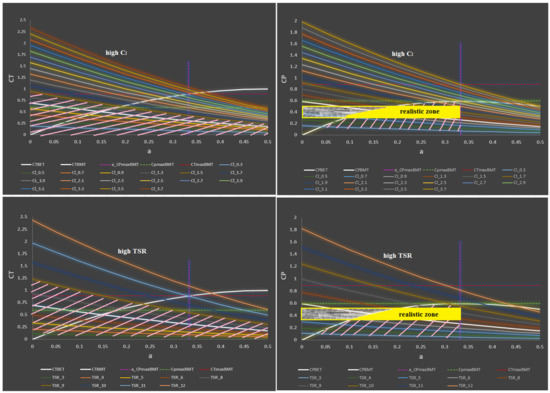
Figure 22.
Realistic zones for Cl(r), λ(r) and CT and CP of solo wind turbines as a function of a from BET and BMT. Crossed areas are individual realistic zones and the yellow-colored area is the realistic CP zone.
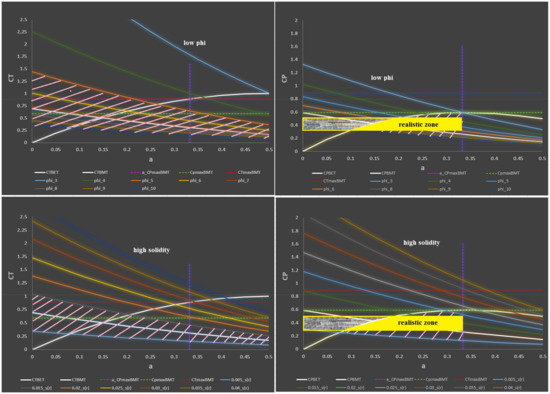
Figure 23.
Realistic zones for φ(r), σ(r) and CT and CP of solo wind turbines as a function of a from BET and BMT. Crossed areas are individual realistic zones and the yellow-colored area is the realistic CP zone.
3.2. Comparison between Low and High Fidelity
Performance coefficients are compared for the three designs with py_BEM results from design and analysis approach. Another performance coefficient is the exergetic efficiency (eta_II) calculated for these turbine rotors. It signifies the amount of exergy converted to useful work and is listed in Figure 24, which also shows spanwise thrust and torque distribution per length for design3 for the py_BEM results and 3D solution with coarse (1.2 million points) and finer mesh (8 million).
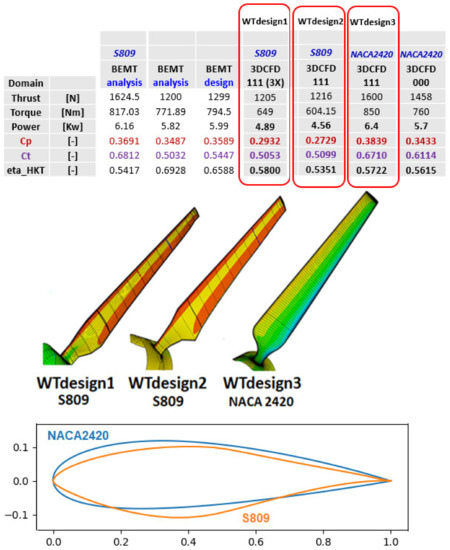
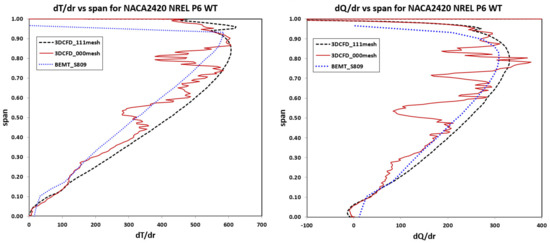
Figure 24.
Three designs compared for the NREL Phase 6 reverse-engineered wind turbine rotor. Spanwise properties at various mesh densities (1 and 6 million) with py_BEM for design3.
The spanwise thrust and torque captured for a very high dense mesh (000 = 6 million) is also plotted in Figure 24 to show the grid-based instability occurring in the steady RANS solver and warrants an unsteady solution, which is out of scope for this study. Table 2 compares the properties of py_BEM results with different domain sizes.

Table 2.
Performances of various 3DCFD domain sizes are compared with py_BEM results.
Figure 25 compares the coefficient of pressure distribution on the blade for S809 and NACA 2420 calculated from XFOIL at several spanwise locations. Clearly, NACA 2420 has a higher coefficient of pressure distribution and lift-to-drag ratio. It has a rounded leading edge that is less sharp compared to S809 and a smoother suction surface that is essential in creating more loading, as seen in the figure. The transition location is earlier than in S809 as well. Figure 26 shows the pressure distribution for NACA 2420 compared between the XFOIL run and 3DCFD cases, plotted at several spanwise locations. The 3D effects due to rotational boundary layers create more lift. The heavy, dense mesh case is also plotted here to show the behavior of the airfoil loading spanwise. The lift is under-predicted in this case due to the grid-based instability of solution for this mesh count (~6 million). Near the tip, there are more losses, which reduces the lift generated. Figure 27 compares the coefficient of pressure distribution on the suction and pressure side for all the three cases at several spanwise locations. The coefficient of pressure distribution is higher in 3DCFD due to rotational effect, except at 95% span. The centrifugal action of the flow from the root to tip also delays stall at higher AoAs. The Coriolis force directs the flow chordwise and together increases the lift distribution as compared to a 2D or a non-rotating 3D wing. In short, a wind turbine is not a rotating wing due to the camber and stagger defined spanwise.
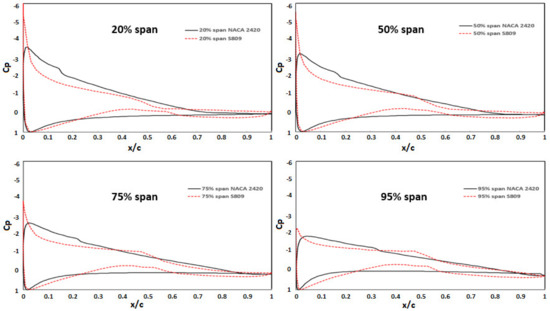
Figure 25.
Airfoil loading at several spanwise locations from XFOIL for S809 and NACA2420 airfoils.
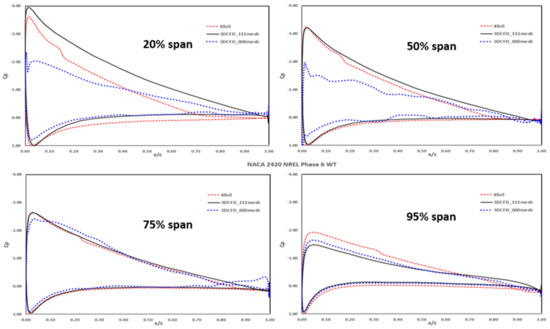
Figure 26.
Airfoil loading at several spanwise locations from XFOIL and 3DCFD for WTdesign3 at coarse and dense mesh configuration.
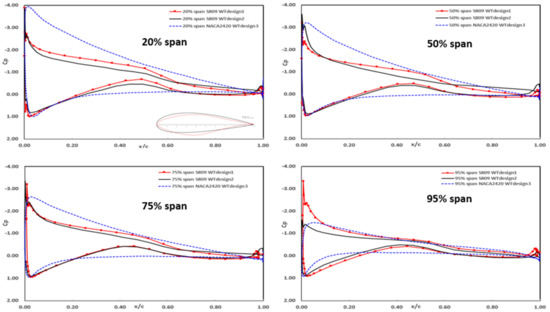
Figure 27.
Airfoil loading at several spanwise locations for wind turbine rotor designs. Design-3 (blue dotted line) with NACA2420 has the optimal distribution.
3.3. Momentum Transport and Wake Analysis
WTDesign2 with 3X domain was used for momentum analysis. The momentum of the flow is transferred to the rotor, and the flow speed reduces downstream. After the wake mixes with free stream, the momentum starts increasing again and reaches very close to the incoming value far downstream.
The velocity deficit normalized with incoming velocity is shown in Figure 28 and shows streamlines in 3D plane. It also shows streamtube expansion at the tip due to the speed reduction. After about 3 diameters downstream, wake mixing with the free stream flow increases the momentum and the velocity deficit starts reducing to zero at very far downstream eventually. The mixing increases the entropy downstream in addition to the entropy created by the hub, tip vortices and the flow mixing at the trailing edge from the pressure and suction sides. Figure 29 shows the wakes downstream at axial locations of 3.34D and 4.7D for all four domains, demonstrating that the flow is very similar up to these locations. Turbulence leads to mixing of the flow sooner and reduces the deficit.
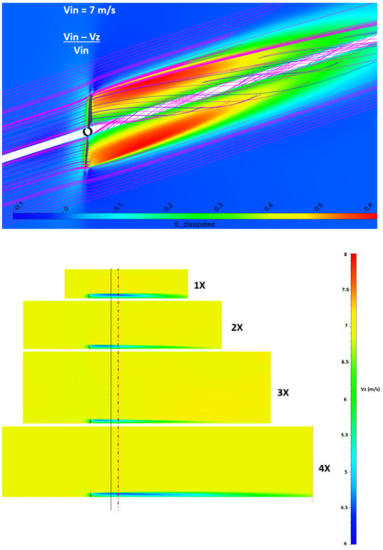
Figure 28.
Perspective view of velocity deficit downstream of the wind turbine rotor showing the streamlines. Different domains showing velocity decrease downstream of rotor.

Figure 29.
Wakes downstream of the wind turbine rotor for all four domains.
Figure 30 plots the axial velocity deficit contours in cross planes downstream and turbulent viscosity ratio in the Y symmetry plane. As the turbulent viscosity ratio increases, the deficit reduces because of KE entrainment. Incoming flow is usually turbulent, and a part of the energy it carries is extracted by the rotor. After the extraction is complete, the turbulence increases due to the turbulent boundary layer leaving the rotor and tip vortices and due to the atmosphere turbulence. Rotating tip vortices isolate the wake from the free stream flow to a certain distance before mixing begins. Axial velocity is the most widespread of all other velocities. It also shows tangential velocity on cross planes with turbulent viscosity ratio in the Y symmetry plane. A similar effect is seen where the increase in the viscosity ratio reduces the tangential velocity downstream of the rotor.
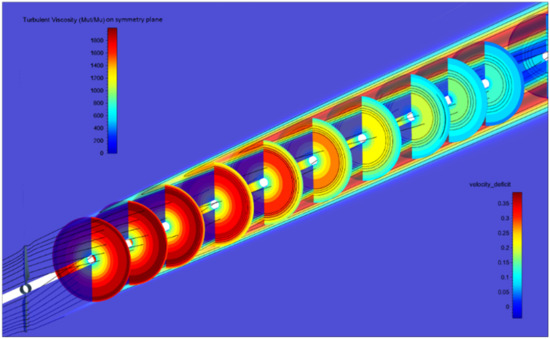
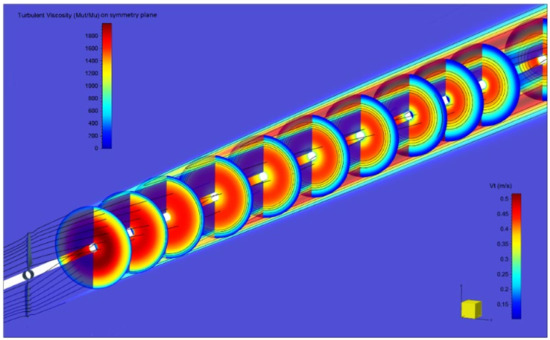
Figure 30.
Velocity deficit downstream of the wind turbine rotor on cross planes and turbulent viscosity in symmetry plane. Second image shows tangential velocity downstream of rotor on cross planes and turbulent viscosity in symmetry plane.
3.4. Vorticity Dynamics and Entropy Increase
Vorticity dynamics was investigated on all three designs using radial vorticity and boundary vorticity flux (BVF) due to tangential pressure gradient with skin friction and vorticity vector lines overlayed on the suction surface. A deeper understanding of the flow physics in the boundary layer and its connection to the entropy rise is explained in detail. Figure 31 shows contours of radial vorticity with skin friction vector lines overlayed, skin friction and BVF due to pressure in axial direction with vorticity vector lines overlayed, intermittency, y+ and entropy gradients in all three directions in the boundary layer of the rotor for all three designs. Figure 32 compares the radial vorticity on the suction surface with skin friction vector lines overlayed for all three designs and provides useful information about the flow dynamics in the boundary layer. Negative radial vorticity on larger portion of the boundary layer on the suction side is favorable for higher torque generation [58].
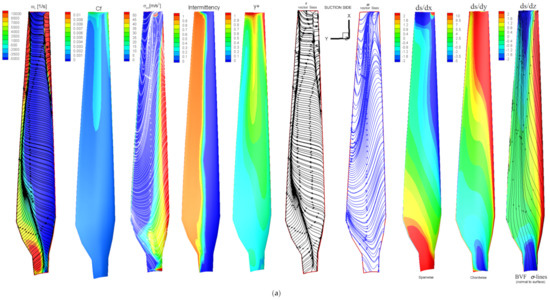
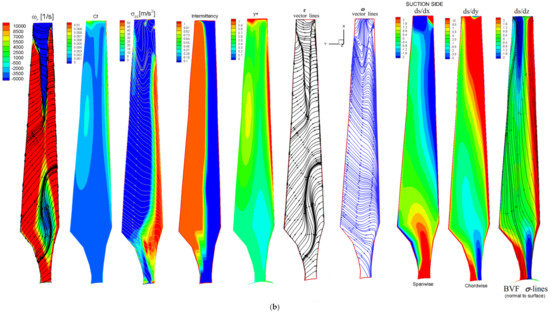
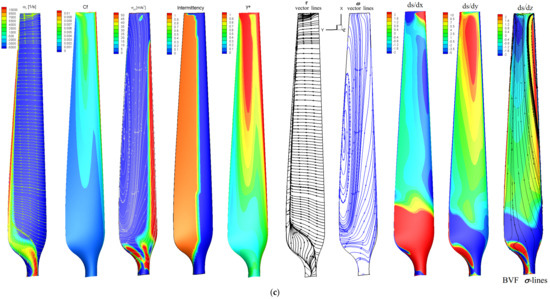
Figure 31.
(a) Properties plotted on the suction side using vorticity dynamics for WTdesign1 with S809 airfoil. (b) Properties plotted on the suction side using vorticity dynamics for WTdesign2 with s809 airfoil. (c) Properties plotted on the suction side using vorticity dynamics for WTdesign3 with NACA2420 airfoil.
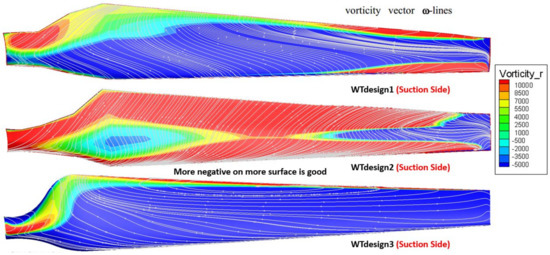
Figure 32.
Radial vorticity with vorticity vector and ω lines on design 1, 2 and 3 compared.
WTdesign1 has a good distribution except in the top 25% span near the leading and trailing edges. The vorticity vector lines have larger curvatures, which also shows the transition to the turbulent boundary layer in the top 25% span. The chord is not well-defined in the bottom 15%, which affects the vorticity distribution. In Figure 31a, the first contour with skin friction vector lines shows lines of attachment near the leading edge in the top 30% span shown by arrows diverging from the line, and it also shows lines of detachment in the same span near the trailing edge shown by arrows converging to the line. The detachment line exists throughout the entire span from 20% chord at the root. This is due to constant AoA of 8 degrees spanwise for the S809 airfoil. WTdesign2 has higher positive peaks of radial vorticity across the span, which reduces global lift distribution through lesser amounts of circulation. In Figure 31b, the first contour plots the radial vorticity with skin friction vector lines overlayed. There is a small zone of negative radial vorticity in the bottom 20% span from 10–50% chord. This distribution is due to not using an optimum spanwise AoA distribution providing the best lift-to-drag ratios for the S809 airfoil with the defined chord. Those in the top 50% in span have lines of attachment near the leading edge and detachment near the trailing edge originating from the same location at mid-span. WTdesign3 has more uniform flow on most parts of the suction surface except near the trailing edge. Spanwise AoA is varied by using AoA from the NREL report using NACA 2420 airfoils. The smooth curvature in the 10% span near the root where the blade cross section transitions from circular to NACA 2420 airfoil assists in creating a better lift distribution. WTdesign3 has the best BVF distribution spanwise.
Figure 33 compares the chordwise entropy gradient on suction surface for all three designs to reveal a direct connection between radial vorticity and entropy generation. BVF vector lines are overlayed on top of the contours. Positive peaks of radial vorticity on the blade boundary layer create higher entropy gradients, as seen in the figure when compared with the previous figure. BVF vector lines have larger curvature in the zones of higher entropy gradients. The smooth curvature in the root portion of WTdesign3 has the least entropy gradient among all three designs. Blade curvature and spanwise AoA distribution are crucial for a better-performing wind turbine rotor.

Figure 33.
Chordwise entropy gradient with BVF due to tangential pressure gradient vector and σ p lines on design 1, 2 and 3 compared.
3.5. Kinetic Energy Dissipation as Entropy Rise
Kinetic energy in the incoming flow is extracted by the rotor, and, after mixing with free stream flow downstream, it is restored to the near inlet value, as shown in Figure 34, for both mesh densities with the turbine location shown as well for WTdesign3 with NACA 2420 airfoil. The normalized energy is plotted as area integral for several axial locations. Dissipation is the entropy rise in the case of incompressible fluid flow due to a very small amount of heat transfer component [49]. KE dissipation can be tracked and quantified as performance loss, as shown in Figure 35. The mass-averaged dissipation function from the Navier–Stokes equation set is evaluated in the axisymmetric view. At about 3–4 diameters downstream of the rotor, the mixing of the wake with the free stream flow begins, and this continues up to 25D downstream where the velocity deficit is the smallest in the extreme far wake.

Figure 34.
Kinetic energy downstream of the wind turbine rotor for 4X domain with coarse and fine mesh (left) and normalized velocity and kinetic energy showing energy transfer and mixing of the flow (right).

Figure 35.
Kinetic energy dissipation downstream of the wind turbine rotor.
Figure 36 shows several aerodynamic properties plotted to demonstrate the connection between them and the flow behavior. Slope of streamline, axial velocity, vorticity_y, turbulent viscosity ratio, dissipation and entropy are all plotted. Turbulent viscosity ratio is the highest in the same zone where mixing begins; dissipation starts reducing shown in red rectangle in the figure. In this zone, the vorticity_y contour shows that the clearly defined tip vortices start mixing with the free stream, and the velocity deficit begins to reduce. The entropy rise increases in this location due to mixing.
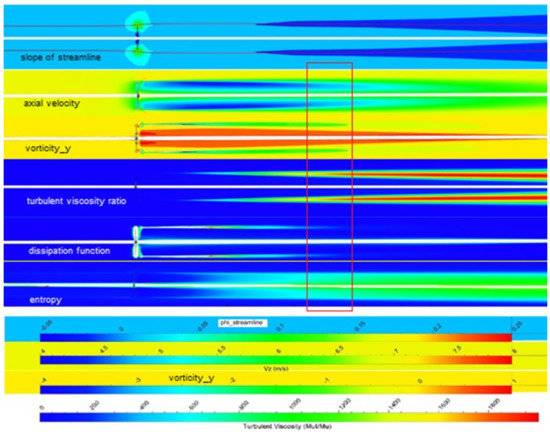
Figure 36.
Several aerodynamic properties downstream of wind turbine rotor for comparison.
3.6. Drag as a Form of Entropy
Mass-averaged induced drag per area is shown in Figure 37 for the wind turbine rotor WTdesign3. The high lift distribution also causes the induced drag near the vicinity of the rotor and slowly reduces and vanishes near the mixing location. Profile drag is based on the entropy rise as shown in the equations below [49], so it takes the same form as the entropy contour. Drag minimization is essential for the wind farm to improve power production. It can be tracked in terms of skin friction on the blade boundary layer and the connection to streamwise vorticity, profile drag and induced drag downstream through Trefftz plane analysis. Entropy downstream of the wind turbine rotor is shown in Figure 38.

Figure 37.
Induced drag per area downstream of the wind turbine rotor for 4X domain.

Figure 38.
Entropy downstream of the wind turbine rotor for 4X domain.
3.7. Rothalpy and Viscous Power Loss
Shaft power is defined as the product of torque generated by the device times the rotational speed. This is the standard practice in unducted rotors as part of the Euler’s turbomachinery equation. Lyman [59] introduced a viscous power loss term in the total enthalpy equation to complete the energy conversion process. Using conservation of rothalpy in rotating frame, he proved that rothalpy changes due to entropy change from viscous dissipation, heat transfer and work done by viscous stress on the relative flow in rotating frame.
A common practice is to assume rothalpy is constant in turbomachine throughflow calculations to simplify the differential energy equation to an algebraic form along the streamlines, as discussed by Lyman. Most of the loss models use this technique and do not account for the viscous power loss term. It is very difficult to quantify the entropy production due to viscous dissipation. Lyman provides an alternate form [59] for the rothalpy differential equation including a term called ‘rotary stagnation pressure’. He derived the following equations in his paper to show that rotary stagnation pressure in incompressible, isentropic flows can be called rothalpy, . This pressure is conserved in steady flow if the net viscous and body forces are absent.
Using a 3D steady solution of a wind turbine case, it is demonstrated for the first time ever that rotary stagnation pressure is not conserved by plotting the values on a cross-sectional area in front and aft of the rotor. The planes are very close to it, as shown in Figure 39. The figure also shows the change in angular momentum by plotting it on the same plane. This difference in rotary stagnation pressure proves that rothalpy is not conserved due to viscous power loss in shaft power.
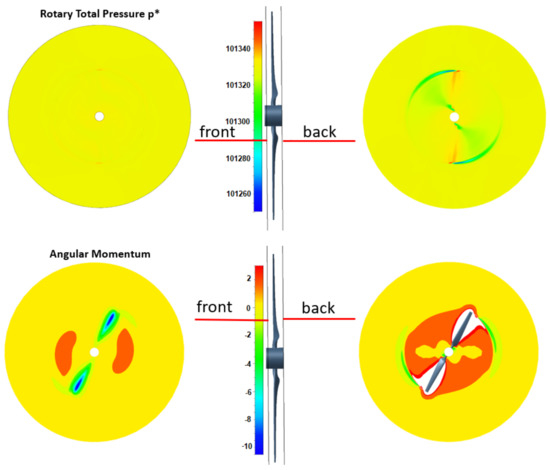
Figure 39.
Rotary total pressure and angular momentum very close to the front and back of the wind turbine rotor, demonstrating that rothalpy is not constant. A viscous power loss exists in the shaft power.
4. Conclusions
Several physics-based enhancements are embedded in a low-fidelity general unducted rotor design analysis tool, py_BEM, including local Reynolds number effects, rotational corrections to airfoil polar, stall delay model, high induction factor correction, polar at large angle of attack, exergetic efficiency calculation and momentum-based loss. A wind turbine rotor is analyzed in high fidelity designed from py_BEM. It is a design derived from the NREL Phase VI rotor. Three design variations are analyzed using steady 3D CFD solutions. S809 and NACA 2420 airfoil properties are used for calculating the aerodynamic loading. Momentum, vorticity and energy transport are explained in depth and connected to entropy production as a measure of performance loss. Rotational effect on the boundary layer is shown using coefficient of pressure distribution between XFOIL and 3DCFD runs. Turbulent mixing reduces the velocity deficit and increases entropy. Wake analysis shows that the mixing with the free stream flow begins after 3 diameters downstream of the rotor and extends to about 25 diameters until the decay is very small and gets closer to the incoming flow speed. Vorticity dynamics is investigated using BVF technique to demonstrate the relationship between streamwise vorticity and lift generated in boundary layer. KE dissipation downstream of the rotor is shown to be the entropy rise. It is demonstrated using rothalpy that shaft power is not just torque multiplied by omega: a viscous power loss term must be included. This viscous power loss can also be used to understand the difference between power extracted from the wind of a wind turbine and the angular momentum change. A multifidelity approach to analyze rotor aerodynamics with a focus on loss propagation originating in the boundary layer has been demonstrated.
Author Contributions
Conceptualization, K.S. and M.T.; methodology, K.S. and M.T.; software, K.S.; formal analysis, K.S.; resources, M.T.; data curation, K.S.; writing—original draft preparation, K.S.; visualization, K.S.; supervision, M.T.; project administration, M.T. All authors have read and agreed to the published version of the manuscript.
Funding
This research received no external funding.
Institutional Review Board Statement
Not Applicable.
Informed Consent Statement
Not Applicable.
Acknowledgments
The authors acknowledge the aerospace department of University of Cincinnati for providing computing resources to perform heavy simulations in HPC.
Conflicts of Interest
The authors declare no conflict of interest.
Nomenclature
| a, a′ | Axial and angular induction factors |
| Cl, Cd | Coefficient of lift and drag |
| CT, CP | Coefficient of thrust and power |
| dF, D, L | Elemental force, drag, lift |
| f | Frictional |
| h | Enthalpy |
| I | Rothalpy |
| m | Mass flow |
| p, P | Pressure, Power |
| U | Rotational Velocity |
| V | Absolute Velocity |
| W | Relative Velocity |
| s | Entropy |
| y+ | Non-dimensional wall distance |
| α | Angle of Attack |
| μ | Dynamic viscosity |
| υ | Kinematic viscosity |
| Ω | Rotational speed of the rotor |
| ω | Vorticity vector, angular velocity |
| φ, Φ | Flow angle, streamline slope, dissipation function |
| ρ | Fluid Density |
| σ | Boundary vorticity flux |
| τ | Skin friction vector |
| θ | Twist angle, tangential direction |
References
- Wilson, R.E.; Lissaman, P.B.S. Applied Aerodynamics of Wind-Power Machines; NTIS: Alexandra, VI, USA, 1974. [Google Scholar]
- Manwell, J.F.; McGowan, J.G.; Rogers, A.L. Wind Energy Explained: Theory, Design and Application, 1st ed.; J.W & Sons, Inc.: Middle River, MD, USA, 2002. [Google Scholar]
- Gundtoft, S. Wind Turbines; University College of Aarhus: Aarhus, Denmark, 2009. [Google Scholar]
- Masters, I.; Chapman, J.C.; Wills, M.R.; Orme, J. A robust blade element momentum theory model for tidal stream turbines including tip and hub loss corrections. J. Mar. Eng. Technol. 2011, 10, 25–35. [Google Scholar] [CrossRef] [Green Version]
- Masters, I.; Chapman, J.C.; Orme, J.; Wills, M.R. Modelling high axial induction flows in tidal stream turbines with a corrected blade element model. In Proceedings of the 3rd International Conference on Ocean Energy, Bilbao, Spain, 6–9 October 2010. [Google Scholar]
- Ingram, G. Wind Turbine Blade Analysis Using the Blade Element Momentum Method Version 1.1; Durham University: Durham, UK, 2011. [Google Scholar]
- Liu, S.; Janajreh, I. Development and application of an improved blade element momentum method model on horizontal axis wind turbines. Int. J. Energy Environ. Eng. 2012, 3, 30. [Google Scholar] [CrossRef] [Green Version]
- Stępień, M.; Kulak, M.; Jóźwik, K. “Fast Track” Analysis of Small Wind Turbine Blade Performance. Energies 2020, 13, 5767. [Google Scholar] [CrossRef]
- Abedi, H. Aerodynamic Loads on Rotor Blades. Master’s Thesis, Chalmers University of Technology, Gothenburg, Sweden, 2011. [Google Scholar]
- Moriarty, P.J.; Hansen, A.C. AeroDyn Theory Manual; NREL/TP-500-36881; National Renewable Energy Laboratory: Golden, CO, USA, 2005. [Google Scholar]
- Marten, D.; Wendler, J.; Pechlivanoglou, G.; Nayeri, C.N.; Paschereit, C.O. Qblade: An open source tool for design and simulation of horizontal and vertical axis wind turbines. Int. J. Emerg. Technol. Adv. Eng. 2013, 3, 264–269. [Google Scholar]
- Drela, M. Xfoil. Available online: https://web.mit.edu/drela/public/web/xfoil/ (accessed on 25 December 2013).
- Sant, T.; Kuik, G.; Bussel, G.J.W. Estimating the angle of attack from blade pressure measurements on the NREL Phase VI rotor using a free wake vortex model: Axial conditions. Wind Energy 2006, 9, 549–577. [Google Scholar] [CrossRef]
- Sant, T. Improving BEM-Based Aerodynamic Models in Wind Turbine Design Codes. Ph.D. Thesis, DUWIND Delft University Wind Energy Research Institute, Delft, The Netherlands, 2007. [Google Scholar]
- Merrill, R.S. Nonlinear Aerodynamic Corrections to Blade Element Momentum Module with Validation Experiments. Master’s Thesis, Utah State University, Logan, UT, USA, 2011. [Google Scholar]
- Dumitrescu, H.; Cardos, V. Rotational Effects on the Boundary-Layer Flow in Wind Turbines. AIAA J. 2004, 42, 408–411. [Google Scholar] [CrossRef]
- Carcangiu, C.E.; Sorensen, J.N.; Cambuli, F.; Mandas, N. CFD RANS analysis of the rotational effects on the boundary layer of wind turbine blades. J. Phys. Conf. Ser. 2007, 75, 012031. [Google Scholar] [CrossRef]
- Breton, S.P.; Coton, F.N.; Moe, G. A study on rotational effects and different stall delay models using a prescribed wake vortex scheme and NREL phase VI experiment data. Wind Energy 2008, 11, 459–482. [Google Scholar] [CrossRef]
- Herraez, I.; Stoevesandt, B.; Peinke, J. Insight into Rotational Effects on a Wind Turbine Blade Using Navier Stokes Computations. Energies 2014, 7, 6798–6822. [Google Scholar] [CrossRef] [Green Version]
- Zhong, W.; Shen, W.Z.; Wang, T.G.; Zhu, W.J. A New Method of Determination of the Angle of Attack on Rotating Wind Turbine Blades. Energies 2019, 12, 4012. [Google Scholar] [CrossRef] [Green Version]
- Revaz, T.; Lin, M.; Porté-Agel, F. Numerical Framework for Aerodynamic Characterization of Wind Turbine Airfoils: Ap-plication to Miniature Wind Turbine WiRE-01. Energies 2020, 13, 5612. [Google Scholar] [CrossRef]
- Ge, M.; Fang, L.; Tian, D. Influence of Reynolds Number on Multi-Objective Aerodynamic Design of a Wind Turbine Blade. PLoS ONE 2015, 10, e0141848. [Google Scholar] [CrossRef] [PubMed]
- Koh, W.X.M.; Ng, E.Y.K. Effects of Reynolds number and different tip loss models on the accuracy of BEM applied to tidal turbines as compared to experiments. Ocean Eng. 2016, 111, 104–115. [Google Scholar] [CrossRef]
- McCrink, M.H.; Gregory, J.W. Blade Element Momentum Modeling of Low Reynolds Electric Propulsion Systems. J. Aircr. 2017, 54, 163–176. [Google Scholar] [CrossRef]
- Shen, W.Z.; Mikkelsen, R.; Sorensen, J.N.; Bak, C. Tip loss corrections for wind turbine computations. Wind Energy 2005, 8, 457–475. [Google Scholar] [CrossRef]
- Masters, I.; Williams, A.; Croft, T.; Togneri, M.; Edmunds, M.; Zangiabadi, E.; Fairley, I.; Karunarathna, H. A Comparison of Numerical Modelling Techniques for Tidal Stream Turbine Analysis. Energies 2015, 8, 7833–7853. [Google Scholar] [CrossRef] [Green Version]
- Wood, D. Wake Expansion and the Finite Blade Functions for Horizontal-Axis Wind Turbines. Energies 2021, 14, 7653. [Google Scholar] [CrossRef]
- Wei, X.; Huang, B.; Liu, P.; Kanemoto, T. Performance Research of Counter-rotating Tidal Stream Power Unit. Int. J. Fluid Machin. Syst. 2016, 9, 129–136. [Google Scholar] [CrossRef] [Green Version]
- Belloni, C. Hydrodynamics of Ducted and Open-centre Tidal Turbines. Ph.D. Thesis, Balliol College, University of Oxford, Oxford, UK, 2013. [Google Scholar]
- Heidarpoor, V.; Rosen, M.A.; Mirzaee, I. Numerical investigation of local entropy generation for laminar flow in rotating-disk systems. J. Heat Transf. 2010, 132, 091701. [Google Scholar]
- Stickle, W.G.; Crigler, J.L. Propeller Analysis from Experimental Data; Technical Report No. 712; Langley Memorial Aeronautical Laboratory, NACA: Hampton, VI, USA, 1941. [Google Scholar]
- Denton, J.D. Loss mechanisms in turbomachines. J. Turbomach. 1993, 115, 621–656. [Google Scholar] [CrossRef]
- Lawson, M.J.; Li, Y.; Sale, D.C. Development and verification of a computational fluid dynamics model of a horizontal-axis tidal current turbine. In Proceedings of the 30th International Conference on Ocean, Offshore and Arctic Engineering (OMAE), online, 21–31 July 2011. [Google Scholar]
- Aranake, A.; Lakshminarayan, V.; Duraisamy, K. Assessment of Transition Model and CFD Methodology for Wind Turbine Flows; American Institute of Aeronautics and Astronautics: Reston, VI, USA, 2012. [Google Scholar]
- Rui, Z.; Jili, R.; Haibo, L.; Fang, R. Definition of turbulent boundary-layer with entropy concept. In Proceedings of the MATEC Web of Conferences (ICMMR), Chongqing, China, 15–17 June 2016. [Google Scholar]
- Martini, F.; Montoya, L.T.C.; Ilinca, A. Review of Wind Turbine Icing Modelling Approaches. Energies 2021, 14, 5207. [Google Scholar] [CrossRef]
- Siddiqui, M.S.; Khalid, M.H.; Badar, A.W.; Saeed, M.; Asim, T. Parametric Analysis Using CFD to Study the Impact of Geometric and Numerical Modeling on the Performance of a Small Scale Horizontal Axis Wind Turbine. Energies 2022, 15, 505. [Google Scholar] [CrossRef]
- Michna, J.; Rogowski, K.; Bangga, G.; Hansen, M.O.L. Accuracy of the gamma re-theta transition model for simulating the DU-91-W2-250 airfoil at high Reynolds numbers. Energies 2021, 14, 8224. [Google Scholar] [CrossRef]
- McCroskey, W.J. Measurements of Boundary Layer Transition, Separation and Streamline Direction on Rotating Blades; Technical Report NASA TN D-6321; Ames Research Center, U.S. Army Air Mobility R&D Laboratory: Moffett Field, CA, USA, 1971. [Google Scholar]
- Lee, K.; Roy, S.; Huque, Z.; Kommalapati, R.; Han, S. Effect on Torque and Thrust of the Pointed Tip Shape of a Wind Turbine Blade. Energies 2017, 10, 79. [Google Scholar] [CrossRef] [Green Version]
- Slew, K.L. A Numerical Investigation of Dual-Rotor Horizontal Axis Wind Turbines Using an In-House Vortex Filament Code (dr hawt). Master’s Thesis, Carleton University, Ottawa, ON, Canada, 2017. [Google Scholar]
- Simms, D.A.; Robinson, M.C.; Hand, M.M.; Fingersh, L.J. A comparison of baseline aerodynamics performance of optimally twisted versus non-twisted HAWT blades. In Proceedings of the Fifteenth ASME Wind Energy Symposium, Houston, TX, USA, 28 January–2 February 1996. number NREL/TP-442-20281. [Google Scholar]
- Somers, D.M. Design and Experimental Results for the s809 Airfoil; Technical Report NREL/SR-440-6918; Airfoils Incorporated, Pennsylvania State College: University Park, PA, USA, 1997. [Google Scholar]
- Xu, G.; Sankar, L. Application of a Viscous Flow Methodology to the NREL Phase VI Rotor; American Institute of Aeronautics and Astronautics: Reston, VI, USA, 2002. [Google Scholar]
- Esfahanian, V.; Pour, A.S.; Harsini, I.; Haghani, A.; Pasandeh, R.; Shahbazi, A.; Ahmadi, G. Numerical analysis of flow field around NREL Phase II wind turbine by a hybrid CFD/BEM method. J. Wind Eng. Ind. Aerodyn. 2013, 120, 29–36. [Google Scholar] [CrossRef]
- Duque, E.; Dam, C.; Hughes, S. Navier-Stokes Simulations of the NREL Combined Experiment Phase II Rotor; American Institute of Aeronautics and Astronautics: Reston, VI, USA, 1999. [Google Scholar]
- Pierce, W.T. Evaluation and Performance Prediction of a Wind Turbine Blade. Master’s Thesis, University of Stellenbosch, Stellenbosch, South Africa, 2008. [Google Scholar]
- Siddappaji, K. Parametric 3d Blade Geometry Modeling Tool for Turbomachinery Systems. Master’s Thesis, University of Cincinnati, Cincinnati, OH, USA, 2012. [Google Scholar]
- Siddappaji, K. On the Entropy Rise in General Unducted Rotors Using Momentum, Vorticity and Energy Transport. Ph.D. Thesis, University of Cincinnati, Cincinnati, OH, USA, 2018. [Google Scholar]
- Du, Z.; Selig, M.S. The effect of rotation on the boundary layer of a wind turbine blade. Renew. Energy 1999, 20, 167–181. [Google Scholar] [CrossRef]
- Nemnem, A.F.; Turner, M.G.; Siddappaji, K.; Gannon, A.J. An automated 3d turbomachinery design and optimization system. J. Multidiscip. Eng. Sci. Technol. 2015, 2, 3345–3359. [Google Scholar]
- Balasubramanian, K.; Turner, M.G.; Siddappaji, K. Novel curvature-based airfoil parameterization for wind turbine application and optimization. In Proceedings of the ASME Turbo Expo 2017, Charlotte, NC, USA, 26–30 June 2017. GT2017-65153. [Google Scholar]
- Vince, J. Mathematics for Computer Graphics, 2nd ed.; Springer: Stone Harbor, NJ, USA, 2006. [Google Scholar]
- Fineturbo/Autogrid5, Numeca. Available online: http://www.numeca.com/en/products/finetmturbo (accessed on 25 December 2013).
- Corten, G.P. Heat generation by a wind turbine. In Proceedings of the 14th IEA Symposium on the Aerodynamics of Wind Turbines, Boulder, CO, USA, 4 December 2000. NREL, ECN-RX-01-001. [Google Scholar]
- Betz, A. Windenergie und Ihre Ausnutzung Durch Wind-Muhlen:Vandenhoeckund Ruprecht, Vandenhoeck & Ruprecht; Technical Report; Scientific Research: Gottingen, Germany, 1926. [Google Scholar]
- Ragheb, M.; Ragheb, A.M. Wind Turbines Theory-The Betz Equation and Optimal TSR, Fundamental and Advanced Topics in Wind Power; Intech: London, UK, 2011. [Google Scholar]
- Chen, H.; Turner, M.G.; Siddappaji, K.; Mahmood, S.M.Z. Vorticity dynamics based flow diagnosis for a 1.5-stage high pressure compressor with an optimized transonic rotor. In Proceedings of the ASME Turbo Expo 2016, Seoul, Korea, 13–17 June 2016. [Google Scholar]
- Lyman, F.A. On the Conservation of Rothalpy in Turbomachines. J. Turbomach. 1993, 115, 520–525. [Google Scholar] [CrossRef]
Publisher’s Note: MDPI stays neutral with regard to jurisdictional claims in published maps and institutional affiliations. |
© 2022 by the authors. Licensee MDPI, Basel, Switzerland. This article is an open access article distributed under the terms and conditions of the Creative Commons Attribution (CC BY) license (https://creativecommons.org/licenses/by/4.0/).